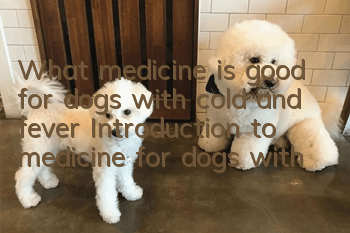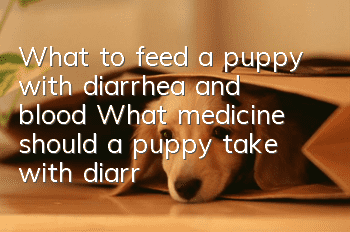What medicine is good for dogs with cold and fever? Introduction to medicine for dogs with cold and fever.

Introduction to dog cold and fever medication:
Dog colds and fevers usually occur in early spring, late autumn and when the climate changes suddenly. Most of the causes are due to sudden cold stimulation, such as being hit by strong winds in winter, sleeping outdoors in cold seasons, being exposed to rain, and not drying the dog's coat in time after bathing.
The main symptoms of colds in dogs are: depressed dogs, loss of appetite or loss of appetite, flushed conjunctiva, and shy and tearful eyes. There is a cough, pus-like nasal discharge, accelerated breathing, elevated body temperature, chills and tremors. If not treated in time, it may be complicated by other diseases such as tracheitis and bronchitis. There is also influenza, which is caused by a virus and occurs in epidemic form. The main manifestation is high fever. In addition to cold symptoms, it is often accompanied by conjunctivitis and intestinal catarrh.
The early symptoms of colds and some infectious diseases have many similarities. You should pay attention to the distinction:
Detailed explanation of dog cold symptoms:
1. Not in good spirits, sluggish, and likes to lie down; (this seems to be a common symptom of all discomforts)
2. Watery nose; (note that it is watery, not purulent or colored)
3. Sneezing and coughing; (coughing is very similar to canine distemper, canine parainfluenza, and bronchitis)
4. Conjunctival congestion, tearing, and loss of appetite; (this is also similar to canine distemper)
5. The body temperature rises, generally 39~40°C; (the normal body temperature measured by rectum for adult dogs is 37.5~38.5°C, and for puppies, 38~39°C)
Differences between similar illnesses and colds:
1. Rhinitis: The body temperature does not rise, the nasal mucosa is red and swollen, and the nasal fluid is pus-like or bloody;
2. Sinusitis: The dog’s mouth and nose have a bad smell, the sinuses are swollen and painful, and the body temperature is low;
3. Canine distemper: The body temperature rises to 40~41°C, and the fever is biphasic (that is, the fever starts for a few days, the body temperature slowly drops, and then the fever returns after about 7 days), and there is sticky secretion in the eyes. ;
4. Canine parainfluenza: contagious, with severe coughing, red and swollen tonsils, and swollen nasal fluid;
5. Bronchitis: severe short cough, dry cough.
Introducing treatment methods and recommending several drugs with better effects
1. Take cold granules. Generally, half a bag is enough at a time. The medicine is mild and there is no big problem if it is overdosed.
2. Take 1 bottle of various oral liquids against cold viruses twice a day.
3. Oral administration&ldquo"Amoxicillin", a pet dog weighing 10 kg should eat about 100 mg. According to this ratio, eat 2 to 3 times a day for one week.
4. The American Pet Research Association has recently confirmed that drinking more chicken soup is miraculous in treating colds.
5. You can feed some radishes, drink some ginger soup, brown sugar tea, eat less salt, and mix some honey in the dog food.
6. Drop vinegar into its nostrils to prevent sterilization.
7. Massage the nose and the whole body to promote blood circulation and ventilation, which is helpful for treatment.
8. Wash your dog’s face with cold water, no matter it is cold in winter or hot or hot, it is very effective in preventing colds.
9. Boil water and place it next to the dog, allowing it to breathe the steam twice a day to speed up recovery.
It is best to go to the pet hospital to give it an injection. It will be a bit slow to give the medicine. If you want to give the medicine yourself, you can usually use bactericidal and anti-inflammatory drugs combined with Chinese patent medicines. For example, you can give amoxicillin combined with antiviral oral liquid or Shuanghuanglian oral liquid, or use ribavirin and Qinghuo Gardenia cereals. See Weight feeding, these are medicines that people take, the price is not high, they are sold in general pharmacies, and the effect is quite good. When a dog has a cold, its appetite will be affected to a certain extent and its food intake will be reduced. In terms of diet, you should give it some palatable, easy-to-digest, less greasy food, and prepare more fresh water for it. It is best to measure its temperature three times a day to facilitate observation of the development of the condition. If any problem occurs, it is best to send it to the doctor in time. Adult dogs are 37.5-38.5℃, and puppies are 38.2-39.3℃. A dog's body temperature changes regularly throughout the day. It is lowest in the morning and slightly higher in the afternoon. The temperature difference between day and night generally does not exceed 1°C. If the temperature difference is too large or the temperature is reversed (high in the morning and low in the evening), it is abnormal.
- Which dog is the cleanest and best to raise? What is the best dog to raise?
- How to quickly detoxify a dog after taking medicine How to quickly detoxify a dog
- What fruits can’t German Shepherds eat?
- How to identify purebred Teddy dogs
- How to tell whether a Basenji is pure or not? Tips for identifying a Basenji
- What vegetables are best for Samoyeds to eat?
- What fruits do Samoyed dogs eat?
- How to tell if an American Cocker Spaniel is pure or not? A guide to selecting a purebred American Cocker Spaniel.
- How to feed Samoyed puppies
- Does the American Cocker Spaniel have a high IQ? Introduction to the American Cocker Spaniel’s IQ



